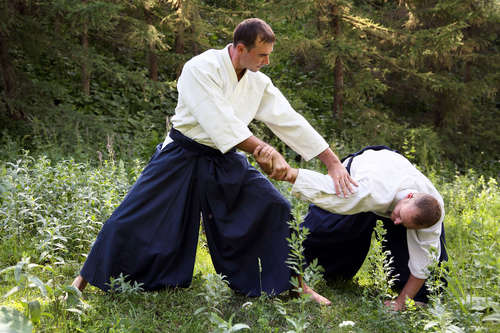SIMILARITIES AND DIFFERENCES BETWEEN CHIN-NA AND JUJIITSU

Japanese Jujitsu, reproduced from http://www.bearmartialarts.com/spage-martial_arts_styles-jiu_jitsu__japanese_.html
Question
he Brazilian variant of Jiu-Jitsu is now a popular and respected martial art worldwide.
Please can you discuss the similarities and differences between Shaolin Qin-na and modern Jiu-Jitsu.
Sifu Andy Cusick
Answer
According to Chinese sources, a Shaolin chin-na master, Chen Yun Pin, went to Japan and taught Japanese warriors. This art evolved to become jujitsu, which means “the art of softness”. Jujitsu sources, as far as I know and I am not sure of its validity, do not mention this Chinese origin.
Japanese jujitsu was an effective fighting art. At the end of the 19th century, jujitsu evolved into judo, which means “the way of softness”, when the founder of judo, Kano Igoro, removed all dangerous techniques of jujitsu and made it into a sport.
In the 20th century, Carlos Gracie developed the art which is now popularly called Brazilian jujitsu. Carlos Gracie, who himself was a world champion, learned from the great Japanese champion, Maeda Mitsuyo, who in turn learned from Kana Igoro.
I do not know enough of jujitsu to give a fair comment on it. Hence my comparison with chin-na is based on my limited knowledge of jujitsu.
Although jujitsu was reputed to originate from chin-na according to Chinese sources, there are more differences than similarities between Shaolin chin-na and modern jujitsu.
A major similarity is that both chin-na and jujitsu employ extensively what may be called gripping. But the similarity is superficial. Gripping in chin-na is on energy points. Gripping in jujitsu, which is actually holding in chin-na terminology, is holding opponents in locks.
In chin-na, a distinction is made between holding and gripping. Holding is keeping in a particular position, whereas gripping is pressing into energy points. Chin-na actually means “holding and gripping”. A chin-na practitioner first holds a part of an opponent’s body, like a limb, then he grips into the opponent’s energy points. Jujitsu, I believe, does not make this distinction between holding and gripping. What is applied by a jujitsu practitioner on an opponent, like keeping the opponent in a lock, is holding.
Another similarity is that both are “soft” arts. (Here the term “arts” is used loosely. Modern jujitsu, protected by safety rules, is more of a martial sport than a martial art.) But chin-na is relatively “harder” than jujitsu.
Again, the similarity is superficial. Shaolin chin-na is an internal art, whereas modern jujitsu is external. In Shaolin chin-na training, much emphasis is placed on essence, energy and mind, whereas in modern jujitsu training, emphasis is placed on external physical movements.
Like the distinction between holding and gripping in chin-na but not in jujitsu, the Chinese master who taught chin-na to his Japanese students probably taught only external forms, leaving our gripping energy points and training of essence, energy and mind.
Basically Shaolin chin-na is a martial art where there are no rules in actual fighting, whereas modern jujitsu is a marital sport protected by safety rules. In Shaolin chin-na, a practitioner can grip an opponent’s throat or genitals, but this is not allowed by safety rules in modern jujitsu.
Paradoxically, despite being a martial art where no rules abide, sparring in chin-na results in far less injuries than in jujitsu where safety rules disallow drastic techniques. A practitioner in chin-na has better control than a practitioner in jujitsu.
Not many people may realize that chin-na techniques, despite appearing to be simple but are actually profound, are combat ending, whereas jujitsu techniques are not, although they may look complicated. In other words, when a chin-na practitioner releases his chin-na techniques, his opponents cannot continue to fight, but a jujitsu practitioner himself is being immobilized when he applies his locks on his opponents.
This is because the chin-na techniques stop the energy flow, resulting in the opponents’ inability to fight. When a jujitsu exponent applies his locks on his opponents, he has to hold on to the locks. When he releases the locks, the opponents are also released and can continue to fight.
There is a lot of ground fighting in modern jujitsu, like in Brazilian jujitsu, but ground fighting is infrequent in Shaolin chin-na. Being a sport, jujitsu practitioners are not allowed to strike their opponents when attempting to take the practitioners down to begin ground fighting. But in a fighting art where there are no protective rules, opponents foolhardy enough to attempt taking practitioners down, will be seriously injured by chin-na practitioners.
Outwardly chin-na and jujitsu may appear similar. But deeper examination shows there are many differences.

Brazilian Jujitsu, reproduced from http://johndonehue.com/brazilian-jiu-jitsu/
LINKS
